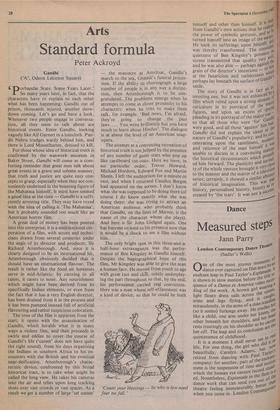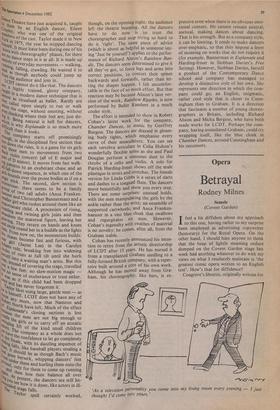Dance
Measured steps
Jann Parry
London Contemporary Dance The° exultant leap in Paul Taylor's Espionade. is shown in slow motion before the title quence of a Dance in America video reco a ding of the work. A brown girl weartgo, light floaty dress sails across the scr.`" arms and legs flying, and is caneng miraculously, in the arms of a man stanch er (so it seems) furlongs away. He cradles bile like a child, one arm under her kneesLlao other beneath her shoulders, and her rests trustingly on his shoulder as he carr,lbe her off. The leap and its conclusion are quintessence of childhood. real
company: for another, part of the
which the human eye cannot record tina.'s a One of the most joyous moments „
beautifully, life. For one thing, the girl who
retired from dancing with Paul TaYiclrr: ment is the suspension of time and ill°t1;d. ed. Nonetheless, Esplanade in the flesh theatre feeling immeasurably better trrn dance work that can send you out of.', when you came in. London Contenifi°/ It is a moment I shall never see "•,, so dance ever captured on film must Vail; Y, Carolyn Adams, has 03,, (Sadler's Wells) encha.ori o of 1/ance Theatre have just acquired it, taught them by an English dancer, Eileen -41eY, who was one of the original 1,1ertibers of the cast. Taylor made it in New hii,9rk in 1975, the year he stopped dancing 'd:self. It must have been during one of his a;."‘vn with choreography' phases, for there e‘e no dance steps in it at all. It is made up of everyday movements — walking, r1110„1.11,11irlg, falling, crawling. He wanted it to fr."'aS though anybody could jump up nrri the audience and join in. afLCDT cannot do it like that. The dancers tae a highly trained, glossy company, in a modern dance technique that is eOst as ritualised as ballet. Rarely are abY called upon simply to run or walk evnlit the stage, without emoting, without iben thinking where their feet are; just do- Being natural is hell for dancers, difire" is Why Esplanade is so much more
Ticult than it looks.
enohile,_ Company starts off promisingly lav-,111, in the disciplined first section that at;ci 'own the rules. It is a game for six girls Ilachee men to movements from two P ofvicilin concerti (all of E major and art b Minor). It moves from fast walk- Patterns to an exuberant chase and an girkakii'down sequence, in which one of the Do; bounds over the prone bodies as if on a illy's°t !tick. The second, slow section is gt-o-etinus: there seems to be a family haelip of two tall adults (Anca Franken- vn user and Christopher Bannerman) and a girl who rushes around them like an k,intinate child. A procession of rising, abZling and twining girls joins and then ,5clis the maternal figure, leaving her ine,11g. They return on hands and knees rad Circle round her in a huddle as the lights r°Irn now on, the momentum builds: erte"iases become fast and furious, with Atl,!irl (Jayne Lee) in the Carolyn cireC,,,s role, breaking free into widening hers-i', of runs at full tilt until she hurls
iltai,'insititetaoda waiting man's arms. But this of covering the stage, travelled
bIlt a few feet: no slow-motion magic — It wrlo sense of exuberance or trust either. oliee4,..as if this child had been dropped
d has never forgotten it.
' he ,..1°1' likes using large, gentle men — as LCDT does not have any of Itoi..; any More, now that Namron and Of tell North have left. Much of the effect bee4,!Pkinade's closing sections is lost Nti,se e ,,"ic men are not big enough to 'tie girls or to carry off an ecstatic ',408lLìglift of the kind small children Yet h;* 'he company as a whole does not the confidence to let go completely ,Ilrter,r14.nale, with its dazzling sequence of N.°,:alls, like baseball players stealing a 44 41. should be as though Bach's music Ito.8°1-1e berserk, whipping dancers' feet ietc'ti tinder them and hurling them onto the kIrlci, only for them to come up running 4gairt.(1,, then lose their balance all over liagy 'V Present, the dancers are still let- iatieecill see how it is done, like actors in ill- , Thaled stage falls. TaYlOr spell certainly worked, though, on the opening night: the audience left the theatre beaming. All the dancers have to do now is to trust the choreographer and stop trying so hard to do it 'right'. The same piece of advice (which is about as helpful as someone say- ing 'Just be yourself') applies to the perfor- mance of Richard Alston's Rainbow Ban- dit. The dancers seem determined to give it all they've got, to force legs and arms into correct positions, to contort their spines backwards and forwards, rather than let- ting the shapes happen. I felt uncomfor- table in the face of so much effort. But that reaction may be because Alston's later ver- sion of the work, Rainbow Ripples, is now performed by Ballet Rambert in a much cooler style. The effort is intended to show in Robert Cohan's latest work for the company, Chamber Dances, to music by Geoffrey Burgon. The dancers are dressed in gleam- ing body tights, which emphasise every curve of their musculature. You can see each vertebra articulate in Celia Hulton's wonderfully flexible spine as she and Paul Douglas perform a sensuous duet to the throbs of a cello and violin. A solo for Patrick Harding-Irmer shows off the male plastique in struts and stretches. The female version for Linda Gibbs is a series of darts and dashes to a tongued flute. The dancers move beautifully and show you every step. There are some surprises: unusual holds, with the men manipulating the girls by the ankle rather than the wrist; an ensemble of supported cartwheels; and Anca Franken- haeuser in a vast blue cloak that swallows and regurgitates six men. However, Cohan's ingenuity with swathes of material is no novelty: he comes, after all, from the Graham stable.
Cohan has recently announced his inten- tion to retire from the artistic directorship of LCDT after 15 years. He has nursed it from a transplanted Graham seedling to a fully-formed British company, with a reper- toire built around a core of his own work. Although he has moved away from Gra- ham, his choreographY, like hers, is ex- pressive even when there is no obvious emo- tional content. He cannot remain neutral, asexual, making dances about dancing. That is his strength. But as a company style, it can be limiting. It tends to make dancers over-emphatic, so that they impose a layer of meaning on works that do not require it (for example, Bannerman in Esplanade and Harding-Irmer in Siobhan Davies's Free Setting). However, Siobhan Davies, herself a product of the Contemporary Dance school and company has managed to develop a distinctive style of her own. She represents one direction in which the com- pany could go; an English, enigmatic, rather cool style that is closer to Cunn- ingham than to Graham. It is a direction that fascinates a number of young choreo- graphers in Britain, including Richard Alston and Micha Bergese, who have both made works for LCDT. Perhaps the com- pany, having assimilated Graham, could try wrapping itself, like the blue cloak in Chamber Dances, around Cunningham and his successors.











































 Previous page
Previous page